Badolato: Into The Heart of Calabria
Badolato Basics
My village, the birthplace of my great-great-grandfather, is Badolato, and it’s located between the Ionian Sea and the Serre Mountains in Calabria, the toe of Italy’s boot.
Badolato, the meaning of which is in dispute (sorry, only in Italian) was founded in 1080 by conqueror and first Duke of Calabria Robert Guiscard, who along with his brother, took over southern Italy and Sicily for the Normans around that time.
Like many villages of this period, Badolato was built on a hilltop about 5 kilometers from the sea with a good view of any approaching ships. Staying too close to the water was considered dangerous not only because of potential invasion–the southernmost part of the peninsula was the gateway to the entire territory now known as Italy and the rest of Europe–but also because of malaria, which was quite common as some of the area was swampland.
View of Badolato Superiore from the winding road leading up to the village.
And so, Badolato was built as a walled city, encircled by stone and guarded by three watchtowers, one of which is still partially standing (below); the town crest honors these watchtowers and the village’s medieval history.
Many of the original walls around the village as well as the old gates that sealed off the city from invaders also remain, but a castle on a hill that was once the town’s centerpiece (thus the name of the main square Piazza Castello) had to be torn down in the 1970s for safety reasons. Previously, it had cast a shadow on all that was below it, as castles are wont to do.
The piazza is now alternately called Piazza Fosso—fosso referring to the huge hole left behind by removing the hill and castle (it didn’t create a hole really, only leveled off the hill the castle had been on).
Political, social, and agricultural history
As rulers changed throughout southern Italy (German, French, Spanish, Turk, Austrian, Bourbon) Badolato felt each influence in turn, which you can hear in Badolatese, the main tongue spoken around here (a version of the Calabrian/Sicilian language, which some (mistakenly) call a dialect), and taste in the traditional Calabrian cuisine, noted for its fondness for the peperoncino, brought back to Italy by Columbus, although also widely used by Arabs who settled here.
Badolato soon became one of the most prominent and wealthiest cities in what is now southern Italy, swelling to a population of 8,000 (some estimates say up to 12,000) and boasting the palazzi of some of the most influential families in southern Europe, mostly due to production of olive oil, wine, and citrus fruit.
The family of the former baron of Badolato still owns a palazzo or two (although they don’t live here full-time) as well as a grand villa that sits on a huge chunk of the land surrounding the village. Almost all of the land around Badolato is still farmed, including that of the former baron, but most of it is was broken into smaller plots as the feudal system died down around the turn of the 20th century.
Incidentally, on the bigger plots, some families built workhouses (no plumbing, electricity, etc.), but still today it is rare for Calabrians to consider actually living on that kind of open land (most prefer village life and traveling by car or by foot to their land). Indeed getting permits to build is difficult as the land is zoned agricultural. Unless it has some existing structure (at least the remains of a wall!), it’s illegal to build a house on these land plots–which means no subdivisions in Calabria’s future. No complaints here.
Religious heritage
Badolato’s importance and deep religious and spiritual history are represented by its 13 churches and 17th century Convento Santa Maria degli Angeli, once a monastery but now a drug and alcohol rehabilitation treatment center; residents produce their own food on site and even operate a restaurant.
Convento nestled among olive trees
(You may remember this old monastery from the Easter procession)
Some say that it’s possible that the Holy Grail was transported here and may still be buried underground somewhere. In 1070, a group of Calabrian monks went to France and established the Ordre de Sion, which later became the Priory of Sion of Dan Brown’s Da Vinci Code fame–said to be the keepers of the Grail. The Calabrian monks returned to Calabria in 1090 but no one knows what, if anything, they brought with them from France; could they have incorporated valuable Christian artifacts into the underground ducts and tunnels of a blossoming Catholic stronghold called Badolato?
Effects of emigration
Like many southern Italian towns, Badolato was a victim of emigration, largely abandoned during two major waves of flight: the first in the early twentieth century (when my family left) and the second after World War II.
In both instances, emigrants were looking for better opportunities, but especially after the second World War when southern Italy was truly war-torn and downtrodden; my 82-year-old neighbor has sung for me a children’s rhyme that complained to Il Duce, Benito Mussolini, that they were living the day without bread and the night without lights (u jornu senza pane, la notte senza luce). A flash flood that wiped out a part of the village in the 1950s surely made the decision to leave easier for many.
Badolatesi fled to, among other places, the United States, Canada, Argentina, Brazil, Germany, Switzerland, and Australia, many leaving behind their homes with only whatever they could carry, never to return.
Others moved just down to the coast, where Badolato Marina was being built in the 1950s–living nearer to the water was now considered safe, plus coastal life was also more convenient with the railroad and highway running through there.
Indeed, P’s mom remembers where there wasn’t even a paved road leading down from the mountain village to the sea–I’ve yet to walk the path, but it’s still there–and anyway, there were only a handful of cars in the village even in to the 1960s, so you can that imagine folks tended to stay close to home.
Because of this mass emigration, the population of Badolato Superiore now stands at about 350 (total population with Badolato Marina is around 4000). This set-up is quite common throughout southern Italy, by the way, so that you’ll often see a “Superiore” town up on the hill/mountain, and its counterpart closer to the sea with “Marina” or “Lido” after the name.
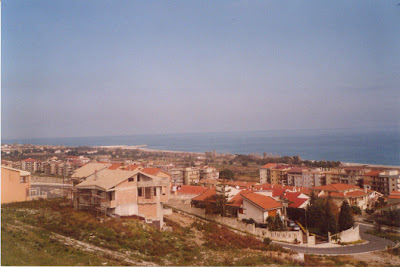 Badolato Marina
Badolato Marina
(Sorry for the poor quality here; it’s an old scanned photo of mine)
The Ship of Kurds
Badolato had fleeting hope of a boom just after Christmas 1997 when 825 Kurdish refugees landed on its shores; this made international news and you can read more about it here (the man on the left in the third photo is my vicino Giuseppe!).
The Badolato community welcomed the Kurds as potential workers and young revitalizers of the old town. The new immigrants are mostly gone now, though, either deported or having left for Germany, France, or elsewhere in the EU for work.
Still, Badolato remains one of the most involved immigration centers in all of Italy in so far as welcoming migrants and helping them with housing, health care, work, and psychological adjustment to life in a new country; one of my translation contracts with the local health care agency involves a special EU project to include cultural and linguistic mediators in this process.
Current and Future Badolato
And yet Badolato remains largely empty, like the village Farfallina wrote about, although the population swells enormously in August when many return to their hometown from Germany, northern Italy, etc., for ferie–Calabria, generally, is quite a hot spot for Italians and other Europeans looking for great, clean beaches.
Even the New York Times agrees.
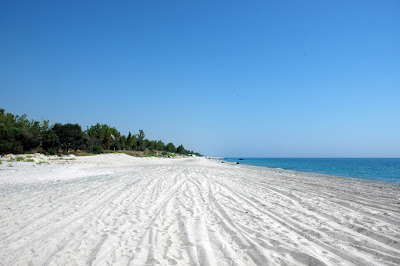 Photo © Franco Muìa
Photo © Franco Muìa
Badolato is undergoing a revitalization, though, as there have already been quite a few properties sold to international buyers over the years; casa by casa things are looking more lived in, although I’m the only year-round foreigner who lives here (Badolatesi would say the transplants from Genoa, Naples, and elsewhere in Italy are also stranieri, but I’m the only non-native Italian).
There is a lot of potential here for tourism, as you can probably imagine, although there would need to be a lot of infrastructure work done first–getting here and getting around isn’t always easy. No one wants to commercialize the town to the point that it’s another Siena or Cortona, overrun with tourists, but a few more visitors, a few more people who want to experience the real Italy complete with women carrying baskets on their heads?
Well that would be nice.
We may not have much support from the government, but we do have green mountains, a clear blue sea, fresh mountain air and water, warm souls, and delicious, fresh food, and for me, that’s certainly plenty.
Final Notes
For those of you who have made it this far (thank you!) and still want more, you can see more photos under the Scenes from Village Life label, my first Virtual Tour, and the two most recent posts: Destination Calabria: Photo Tour of a Medieval Village (Part I) and (Part II).
And if you want to plan a trip, just let me know!
60 Beans of Wisdom to “Badolato: Into The Heart of Calabria”
-
[...] to anyone thinking of showing up in my hilltop village and burgling me: you will still have P and the po... bleedingespresso.com/2008/02/love-thursday-nurturing-my-travel-lovebug.html
-
[...] reminded me a lot of my own beloved town except that Savoca happens to have been where parts of Il Padri... bleedingespresso.com/2008/02/love-thursday-hearts-in-savoca-sicily.html
-
[...] Perhaps you’re confused. That’s OK. You can read all about the Festa di San Giuseppe in last... bleedingespresso.com/2008/03/whats-cooking-wednesday-calabrian-zeppole-for-st-josephs-day.html
-
[...] This year’s Easter Sunday celebrations brought a special visitor to my village: [...]... bleedingespresso.com/2008/03/love-thursday-all-hail-the-princes.html
-
[...] mom’s recipe is from Badolato; my mom’s recipe is essentially my great-grandmother’s, ... bleedingespresso.com/2009/05/whats-cooking-wednesday-stuffed-peppers.html
-
[...] American attorney-turned-freelance writer, moved to her ancestors’ medieval hilltop village of Badola... bialog.ro/2012/01/o-multime-de-bloguri-o-singura-pasiune-italia
-
[...] an American attorney-turned-freelance writer, moved to her ancestors’ medieval hilltop village of Bado... lavitaebellablog.com/blog/2011/05/03/expat-life-interview-with-michelle-fabio


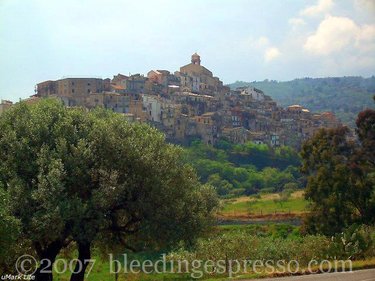
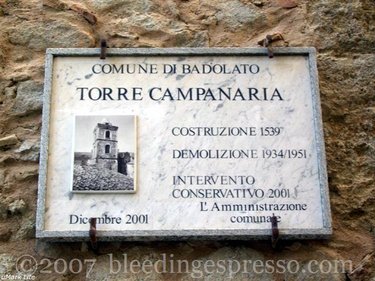
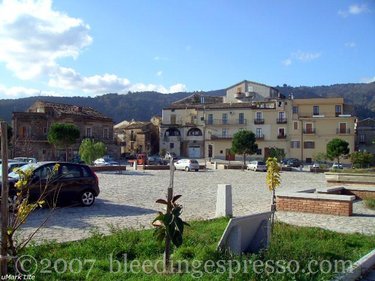

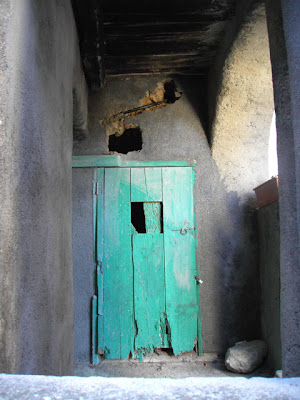












You are unbelievable! I am nearly at a loss for words after reading all that you have written. Your story is so well written that you could sell Badolato to the natives. Thank you so much.
Look like someone has done their homework! I have always heard that it is beautiful in the south, your photos confirm this. Hope to get down your way one day.
Cyn
Aaah! There’s the beautiful post you mentioned you’d write and I was waiting to read 🙂
Wow, what a great post and read! This should definitely be linked to for potential travelers to your town. I was pretty shocked to read that there are only 20 children total in your town. Well, the article is dated “Wednesday, 19 April, 2000, 21:09
GMT 22:09 UK Italy: Immigration or extinction” so obviously those two boys in that photo are older. But still, 20 children total? WOW!
What a great post! The history of your town is fascinating. Now I feel inspired to study the history of my town.
Gil, thank you so much for your kind words; they really mean a lot 🙂
Cyn, be sure to let me know if you’ll be heading my way! The south is wonderful for those who like unspoiled, natural beauty–for better or worse, a lot of stuff down here is still pretty untouched.
Farfallina, yes, here it is! Thanks for the inspiration 🙂
Giulia, even though the article is seven years old, that’s probably still a fairly accurate statistic–although there have been quite a few migrant families with children that have settled here (Ethiopia, Colombia) and that’s upped the total a bit (the boys in that photo are long gone).
That number only addresses, though, the part of Badolato that is up here on the hill–there are many, many more kids in the Marina (enough for a whole elementary school and everything!) 😉
KC, one of the first things I did when I came here was talk to the town historian and get a copy of his book on the village–could barely read a word at the time, but it’s getting clearer. I’m a sucker for history 🙂
I know I repeatedly say this, but the cultural richness where you live – and everywhere near it – is amazing. You are so lucky, and I enjoy your posts like these so very much.
What a fabulous post!!!You’ve absolutely hit on all the essential reasons that keep us coming back. It’s so refreshing to know that others have the deep appreciation for the culture and rich heritage that exists for us.The casual tourists just don’t know what they’re missing!! Grazie mille.
Carol
Yesterday at our horse show there was a booth selling Calabrian foods. It was manned (nice word!) by a young Calabrian who was very very key-yoot!
I ended up buying some atomic salsa do cicoria selvatica piccante, and now have to figure out how to use it.
I will come visit if you will walk that old path with me. Maybe we could drag the suocera along.
your photo of your distant village (hilltop) is postcard-ready! it must be very satisfying to be able to be in and know about your ancestral village so well. i have recently been privy to my mother’s history, traced via church records, to england & hope to soon actually walk in those places…they actually came from france, but the details are sketchy & only the region is certain. but i think i will still go in that general direction.
honestly, given my passion, i am sure they were in italy first!
if your village needs some help in revitalizing some of those abandoned homes, i would gladly step in after Little Man is through with school! 🙂
The local comune should publish that for the English speaking tourists. Beautifully written!
It never ceases to amaze me how northern and southern Italy seem like two totally different countries.
What an incredible post!!! Michele, that must have taken forever to research and write, but it was well worth it! I always wondered if you’d let us know where you lived – please excuse if you already did and I missed it – and I’m thrilled to finally know. My husband and I talk about going to see where his family’s from in Sicily, and I’ve long wanted to explore Calabria on the same trip.
You live in such an exquisite place – it is my absolute dream to do what you’ve done. I know I’ve said that before, but sometimes after reading your posts, I’m just fit to burst with it. Unfortunately, Rob’s a New Yorker through and through.
By the way, I can’t believe the feudal system was in place there up until the 20th C! That’s extraordinary.
Alicia, I’m so glad you like these kind of posts as I *so* enjoy writing them 🙂
Carol, I always think it’s such a shame that there is so little information in English at even our “major” tourist attractions down here–there’s something beautiful no matter where you look, but without the history behind it, well, it loses a lot, IMHO. I’m sure you knew a lot of this info, so thanks for reading 😉
Judith, hmm, I’ve never seen such a salsa, but since a common Calabrian dish is cannellini beans and chicoria with peperoncini, I’m thinking you could work from there.
Glad to provide some regional eye candy.
The walk sounds great, although my suocera probably wouldn’t be up for it–two knee surgeries in about 2 1/2 years 🙁
Qualcosa, I’m in a similar position as you regarding the other heritages in my family–the Italian part just happened to be the easiest to trace. Go figure. I hope you get to visit your roots, even if it’s just a general tour. It was and continues to be quite an emotional experience for me.
And once Little Man is a TV meteorologist, I definitely expect some new neighbors–then when my mom visits there will be Geisinger stories galore!
Jennifer, the south has such an interesting history, I think, precisely because of its location as the gateway to Europe–I have to read more histories of northern cities and especially some of the smaller towns. And thanks for the compliment 🙂
Amanda, would you believe it if I told you that I wrote most of that from memory/general knowledge I’ve picked up here and there over the past four years? I researched this stuff way back when I first came here and it just kind of stuck (although I did double-check some things to be sure). I enjoy history so much anyway, but when you’re talking about history so close to me, well, I just love it that much more.
I always thought I would’ve been a great historical tour guide in Philly…period costumes and whatnot 😉
Wow what detail you put into your post, thank you. It is such a beautiful town one that l would like to visit. The beach looks divine. l wonder if you ever imagined that a place like this would end up being your home.
Such beautiful photos and great information. You are such a wonderful resource for someone planning an Italian vacation (like me!)
sognatrice – you did it again. this was such a beautiful and informative post. I am a big sucker for history as well and I enjoyed reading about your village.
Hello Sognatrice,
I love those posts. Beautiful photos. And the landscape reminds me so much of the South of Greece, especially Laconia. There are alot of villages in the South of Italy that were inhabited since the antiquity and again into the middle ages. Does your village have such a heritage?
Thank you for the beautiful posts!!!
I started and then stopped to go get a cup of tea. I wanted to thoroughly enjoy this post, which I did! Loved it.
What an informative and interesting post. I knew Italy was historic and your post taught me several things I didn’t know!
Thanks for sharing!
Ciao for now! 🙂
Thank you for the fabulous history lesson! What a fascinating and beautiful place you live in. And would I like to plan a trip there? Yes, please! 🙂
You’re amazing!
You’re amazing!
You’re killin me sister.
That’s a palm tree… there by the railroad tracks.
And that’s a sandy beach as white as snow.
And a gorgeous blue sky (no clouds?) and the sea…
sigh.
The countdown has begun.
I will be there.
Great piece, I loved reading every single word.
Thanks!
Scarlett & V.
I started to read, noticed the length and thought “OH, I’ll come back and read this tonight, when I’m off work”…but then I was sucked in and read every last word. Thank you for this pleasant history lesson, I enjoyed learning about your village and the photos were wonderful.
I loved reading this! It is fascinating and the pictures are beautiful.
And… you really have me pegged! I love a good mystery and you can bet that if I lived there I would be looking for a treasure map to lead me to the holy grail!
Absolutely wonderful post! Very enjoyable.
Oh my goodness, this is SO fascinating! I want to go there NOW!
Thank you so much for this post. I’m so happy you showed us all of this. It’s so beautiful there. You must love it. I really enjoy seeing parts of Italy because I have never been. Through you, I get an idea of what it is like and I appreciate that very much. Thank you 🙂
Enjoyed the history of your village, thank you for sharing.
So how difficult is it to get to that area. I’m assuming Trenitalia doesn’t conveniently stop at Badolato Marina.
Amazing how white the beach was, makes you want to wiggle your toes in the sand.
all this beauty and information, too. lovely!
you even managed
to work in *the da vinci code*
as well!
you have it All there, it seems.
**green mountains, a clear blue sea, fresh mountain air and water, warm souls, and delicious, fresh food**
[and your love!]
🙂
yes, you might not want
too many tourist to come visiting…
i see why you might want to stay
where you are!
And a history lesson too! I love history, particularly when it involves Italy.
Bella! Absolutely amazing on so many fronts – the information, the photos, the family heritage, your opinions, he history, the call for tourism. My, my! You have outdone yourself. And I’m not the only one who thinks so according to all these comments. Brava. And I will work on getting some tour groups together to your area as long as you are my local guide. 😉
Great post! Thanks for the info about your town. One of these days, maybe we can make a trip down to Calabria.
Cleopantha, I can honestly say that no, I never would’ve imagined living in a place like this–I wasn’t remotely interested in Italy or even Europe just 6 years ago….
Kathleen, keep my email address on file please–if you need info on Calabria, I’m here!
NYC, it’s kind of sad that history in school is often so boring, isn’t it? Glad you enjoyed the lesson 🙂
Irene, my village hasn’t been around back into antiquities but some nearby ones do have such a history–Locri, Sibari, and Crotone started as some of the first Greek settlements in what is now Italy. There are some nearby ruins, as well, from a Greek city on which a Roman city was later built–La Roccelletta, which I’ll write about someday as well 🙂
Joy, what a wonderful compliment–thanks!
Jennie, good to know I’m spreading the knowledge! Thanks for reading 🙂
Dana, feel free to book the flight!
Shan, I get it–I’m so amazing, it had to be said twice. Why thanks!
Scarlett, the seaside is truly amazing here, which the rest of Europe has already figured out. It’s just taking a while for the rest of the world to show up 😉
Karina, thanks so much for telling me that–I love when that happens, and I’m flattered that I was on the other end of the “sucked in” this time!
Cookie, I’ll start working on that map shortly….
Carol, Jen, thanks! There’s always room in Calabria….
Maryann, thanks for coming along; Calabria is a bit of an unknown even to many Italians, so I’m happy to share.
Linda, actually Trenitalia *does* stop right in Badolato Marina. When I talk about difficulty getting here and around, it’s really the time involved–there are really no direct flights to this area from the US (there were supposed to be experimental routes this summer, though, from NY?), which means you’re already doing a roundabout in some way. The bus and train systems are good, but it’s just difficult to keep a schedule sometimes figuring out how to get around while maximizing time in a given spot. Renting a car is the best idea down here if you’re on even a somewhat tight schedule…but it’s definitely do-able!
SPF, we may not have it All, but we certainly have a lot…and it’s such a pleasure to share with all of you. Hopefully in person someday!
Kathy, glad you enjoyed!
Jeni, I’m sure we can arrange something–I love playing guide!
MB, yeah! Road trip! I have a feeling it’ll end up feeling a lot like Abruzzo for you, but that’s a good thing, right? Come on down!
Your town has such history, and it really does look beautiful. Perhaps when I am living in Calabrian village for a month or two I will have to take a road trip a little further south to see this beautiful town first hand!
Leanne, woohoo! Come on down!
Fantastico. Bravo. 🙂
That sounds like the kind of Italy I wish I’d seen this summer, on the way to Greece.
(Instead, I saw the overdeveloped eastern coastline down to Bari).
I’d call your Italy, definitely, Romantic Italy.
Mikeachim, I’ve never been to the part you’ve described, but I’ve heard similar reviews. Certainly won’t find overdevelopment here, and I’d have to agree with you on the “romantic” part. It’s not all romantic and lovely, of course, but it all depends on what you choose to focus on….
I really enjoy your blog and the recent articles on your little town. My wife is from Florence and we plan to return in the next year, so insight into life in Italy is helpful.
It is true, you should look into writing English language local guides for the town halls. (of course getting paid may be another issue).
Thanks for sharing! John
Ciao Bella,
I had a tiny map of Calabria in my hands and wanted to check how far your village is from Pizzo. So I went back to your blog to find the name of your village…. and there it is, this full detailed post of Badolato with history and perspectives, with remarks about the holy grail and from the New York Times. Wow! Congratulations! The inhabitants must be proud of you and you making their village famous.
Did you research where your Great-Great-Grandfather lived? Are you related to some families in the village? Maybe with P?
John, ah, I see you understand the logistics of working/volunteering in Italia 😉 Thanks for the compliments, and for stopping by!
Suzie, the inhabitants here pretty much have zero idea that I’ve written about the town, but I’m sure they’d appreciate it if they knew 😉
As for my family, I know the quadrant they lived in, which is actually the same one that P’s family has been in for generations–so they surely knew one another, but as far as I know, aren’t related (although I’m sure if we go back far enough, they are). I have some distant cousins that I’ve found here as well, but it seems that my g-g-grandfather was only one of 2 of his family that went to America and the other died early on over there so that his wife and children came back here. So really, almost all of this part of my family is around here somewhere. I still have to research it more though.
What a fabulous post! I saw it when I was at work and have been looking forward to reading it from home with a cup of tea. It didn’t disappoint, (and now, more than ever, I am itching for a vacation.)
What a great post !!! Your post flow so nicely, even in history lessons! I’ll have to agree with some of the others who left comments, you could certainly sell this post for Tourist. Thanks for sharing so much!
Mallow, glad you weren’t disappointed–and that I couldn’t feel the pressure from the time you glanced at the post at work until you read it at home!
Friend, thanks! History can be fun, right?!
I’m fascinated by this because my maiden name was Badolato. Now I’m convinced I’ll have to get there to see it for myself after reading your wonderful article and seeing the photos.
Thanks for sharing!
Yes Tina! Come!
That’s my next project, to find former houses and locations of my family in Italy. I did find one though in Camigliano; my g-grandmother’s farm which is abbandoned unfortunately. But it was great as I had a real connection to the country , I didnt feel like a tourist when I saw that farm. For this reason I get nostalgic when i hear about forgotten italian towns or see pictures like the ones you have here. Seeing that farm really solidified the Italian identity that I had within myself, cemented when I got my Italian passport!
I haven’t been able to pinpoint houses yet, but I really should get on that; I think I have to look at old tax records and stuff…hmm….
Wow, how blessed I feel to have found you through Maria Taccone’s blog “Reflections on my 40 years in Umbria”…I felt that reading Maria’s blog was like reading my own words, and now here you are, and I feel another wonderful connection! My mother and grandmother are from Ferruzzano…I think it must be close in proximity to Badolato and so beautiful as all of Calabria is! I look forward to following this blog and admire your ability to move back…perhaps reversing in a small way the exodus you spoke about that has left so many villages in various stages of abandonment. For this reason I have been painting Calabria for over 17 years in fresco with love and passion for a place that I hold very dear…this summer I created a short video called “My Italy”
http://www.youtube.com/watch?v=CnxorhsKhM0
that showcases the beauty of this place so many love but as you mentioned, perhaps they only return to once a year in August…please watch it as I know you will enjoy it and share it with those that would like another “taste” of Calabria and it’s beauty! Thank you!
I’m also so happy you found me; I will share your video on the blog shortly…will keep you posted! Love your work!!!!
Hello Michelle,
I found this wonderful post in particular while researching Marasa, a band from Badolato that sings in Calabrese. I was just wondering if they were popular in Badolato and what your thoughts are on their music, if you’ve heard them play. I saw them live a few years back and love their sound!
Thanks,
Julia
michelle Reply:
November 17th, 2011 at 10:23 am
I know Marasà well, Julia; I’ve even sung with them on stage haha. The lead singer is a close friend of my husband’s, and another in the band is a relative; they are beloved around here and play at many of our local celebrations 🙂
Michelle,
It wAs always a dream of mine to visit italy. My mother and her family are all born in Rende Cosenza..
My grandparents would always speak about italy and helped raise me in the Italian culture. This is one of the things that I am most proud of and I feel has shaped my identity as a person and now as a father and husband.
Unfortunately both my Grandparents passed before we has a chance to go to italy together. One day I decided that I had waited long enough and felt almost a responsibility to my self and my grandparents to make the trip.
Finally in 2005 I went to italy for the first time. After visiting all the typical tourist spots first I made my way to Rende. I had never met any of my relatives before and did not speak the language.
I went to the main piazza and had dinner. I met some local people and called my great uncles house and made arrangement to meet them there the next day.
What followed was an amazing relationship with a family that I had never known until then. In a way I was transported back in time sitting at my grandparents table.
Since my first visit in 2005 I have returned six times. I have just purchased a home in Zambrone overlooking the ocean. My hope is to have many memmories there with my Canadian family and my new calabrese family who I love dearly. The house is scheduled to be ready to move in July 1 2012. I plan to make up for lost time with my calabrese family. I feel as though I was robbed from the relationship I could have had with my cousins had I been able to spend our summers in Calabria as a child. I would like to do for my own children what my mother and grandparents missed doing for me.
My wife thinks that I romanticize the Italian life but has supported my decision to visit often and now build a home there. This is a big leap of faith as we are not wealthy people. I am quite greatful to her although as she says I would do it anyway. She is a school teacher and I am self employed so spending several weeks in our home in the summer is possible.
I am the only one in my family to return to italy although I, like you, am not a native. I feel that italy is part of my DNA and has some how drawn me there by fate.
It is stories like yours that inspired me to follow my heart even though it makes no logical sense at all. I have never met you and I am sorry to bore you with details, however I feel gratitude to pilgrims like yourself and one day It would be an honor to feel included in the exclusive group that followed their passion all the way to italy.
I understand that these posts are old and there is a chance that you will never read this message, but I would invite you to send me an email. Who knows we may bump into one another in Tropea.
I am a little scared of course. Excitement trumps the “am i freakin nuts” moments that do creap up om me from time to time I don’t have the best grasp of the language although it is getting better. Buying a second home is crazy especially when that home is overseas. Any advice or words of encouragemt would be greatly appreciated.
I will be making a short trip to See my family and shop for furniture and household items we will need this summer.
If I don’t hear from you I hope you have an amazing life in Calabria.
Warm regards,
Michael Topper
michelle Reply:
March 13th, 2012 at 7:22 pm
Such a wonderful story, Michael; thank you for sharing and in bocca al lupo!
Hi Michelle,
I am planning a trip in October to Cosenza and the Ionian coast. I haven’t been to Calabria since 1990 and then it was only Tropea en route to Sicilia. I would like to visit Acri and La Sila. A friend has offered to arrange a visit to Librandi in Ciro Marina. My mother’s family came from Acri and Longobucco but most are long gone according to my late uncle who visited several times. I would appreciate any tips or suggestions. I don’t speak Calabrese much, but I can understand someone if they speak slowly (good luck there Marco). I will probably rent an auto in base-camp Cosenza and drive from there to Acri and La Sila. I am looking at 3-4 weeks right now. You may email me if you would like. Thank you. Your blog has been very helpful.